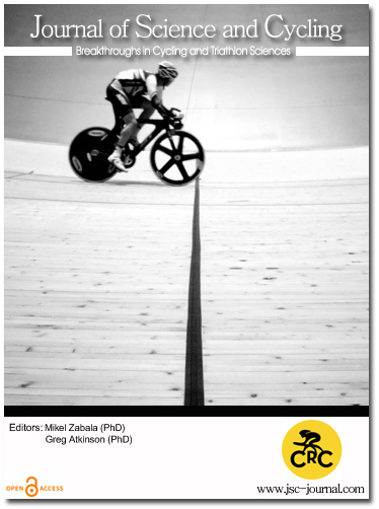The use of the Lamberts Submaximal Cycle Test in Triathlon, an exploratory study in young professional sprint triathletes
LSCT and Triathlon performance
DOI:
https://doi.org/10.28985/1220.jsc.02Keywords:
athletic performance; swimming; bicycling; running; physiology; LSCTAbstract
Abstract: The Lamberts Submaximal Cycle Test (LSCT) has proven itself as an effective tool to monitor and fine-tune training prescriptions for trained to elite cyclists whilst also being able to reflect identifying early symptoms of fatigue and/or overreaching. Although considered a popular monitoring tool in cycling, it is not clear how well the design of the LSCT relates triathlon performance. Therefore, the aim of this initial study was to determine whether a relationship exists between the LSCT and actual sprint triathlon performance in six young professional triathletes. As part of the study all triathletes performed the LSCT 2 days before the Dutch National Championships, while the relationships with overall and split sprint triathlon times were studied. All triathletes successfully finished the National Championships, with 3 winning their age and gender category. A good Spearman’s rho correlation (rs) between between the power output during LSCT stages 2 and 3 and overall sprint triathlon finishing time (rs = -0.94, p = 0.017). As expected, based on the cycling nature of the LSCT, the strongest correlations with split triathlon time, were found between LSCT stages 2 and 3 power output and split cycling time (rs = -1.0, p <0.001 and rs = -0.99, p = 0.006, respectively). Slightly weaker relationships were correlations were found with split running time (rs = -0.94, p = 0.016) and swimming time (rs = -0.94, p = 0.017), while no relationships were found with heart rate recovery. Findings yielded by the initial study suggest that the LSCT relates well to both the overall as well as split triathlon performances of professional athletes. Although a larger sample study is needed to confirm and determine the accuracy of the LSCT in a more heterogenous group of triathletes, the findings of this initially study highlight the potential of the LSCT as useful monitoring tool for triathletes.
Downloads
Published
How to Cite
Issue
Section
Copyright (c) 2020 Journal of Science and Cycling

This work is licensed under a Creative Commons Attribution-NonCommercial 4.0 International License.
Authors contributing to Journal of Science and Cycling agree to publish their articles under a Creative Commons CC BY-NC-ND license, allowing third parties to copy and redistribute the material in any medium or format, and to remix, transform, and build upon the material, for any purpose, even commercially, under the condition that appropriate credit is given, that a link to the license is provided, and that you indicate if changes were made. You may do so in any reasonable manner, but not in any way that suggests the licensor endorses you or your use.
Authors retain copyright of their work, with first publication rights granted to Cycling Research Center.






